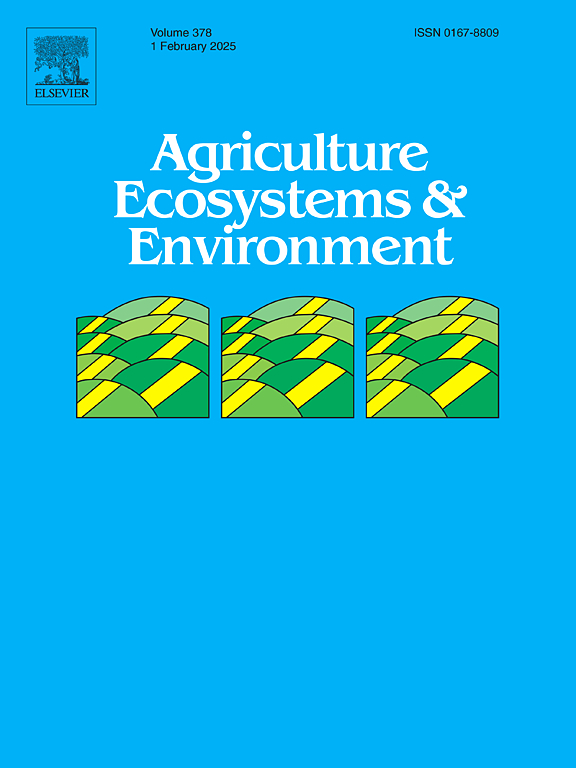大气CO2升高条件下水稻磷利用效率的提高及其驱动因素
IF 6
1区 农林科学
Q1 AGRICULTURE, MULTIDISCIPLINARY
引用次数: 0
摘要
土壤磷(P)是水稻生长发育的第二重要养分,但其利用效率(PUE)仍然很低。与此同时,近几十年来大气二氧化碳(CO2)浓度的升高在全球范围内增加了水稻生物量和产量,但其对水稻PUE的影响尚不清楚。因此,本研究旨在探讨CO2浓度升高对水稻PUE的影响及其机制,基于两年田间自由空气CO2增强(FACE)实验的证据和全球荟萃分析的结果,我们采用开顶箱(OTC)来探索其潜在机制。结果表明,与大气CO2 (ACO2)相比,CO2 (ECO2)升高显著提高了水稻PUE,幅度为16.6 %。CO2浓度升高对粳稻PUE的影响大于籼稻。一项全球荟萃分析的结果也证实了这些发现。结果表明,CO2浓度升高可使水稻地上生物量(AGB)增加27.8% %,土壤有效磷增加20.3% %。研究了CO2对水稻PUE正效应的两个可能驱动因素,即地上生物量的增加和土壤磷酸酶和速效磷含量的增加,两者都可以在CO2升高的条件下增加水稻的P积累。进一步分析表明,这两个因素共同控制了高CO2条件下PUE的升高,其中地上生物量的增加贡献更大。上述结果表明,CO2浓度升高会促进水稻土壤对磷的吸收,加速土壤磷循环。我们的研究结果也可以为在气候变化背景下形成平衡粮食需求增加与有限磷肥资源之间矛盾的管理策略提供重要的益处。本文章由计算机程序翻译,如有差异,请以英文原文为准。
Enhanced rice phosphorus use efficiency under elevated atmospheric CO2 and its drivers
Soil phosphorus (P) is the second most important nutrient for rice growth and development, but its use efficiency (PUE) is still very low. Meanwhile, the elevated atmospheric carbon dioxide (CO2) concentration during recent decades has increased the biomass and rice yield globally, but its impact on the PUE of rice is still not well understood. Therefore, this study aims to explore the effect of elevated CO2 on PUE of rice and its underlying mechanisms, based on the evidence from two-years field free-air CO2 enhancement (FACE) experiment and the results from a global meta-analysis, we use the open-top chamber (OTC) to explore its underlying mechanism. Results showed that compared to atmospheric CO2 (ACO2), elevated CO2 (ECO2) has significantly increased the PUE of rice, with a magnitude of 16.6 %. The effects of elevated CO2 on PUE was higher for Japonica rice than that for Indica rice. These findings were also confirmed by the results from a global meta-analysis. Results based on OTC experiments showed that the aboveground biomass (AGB) of rice increased by 27.8 % and the soil available P increased by 20.3 % with elevated CO2., two possible drivers accounting for the positive CO2 effect on rice PUE were investigated, of which one was the enhanced aboveground biomass and the other one was the enhanced soil phosphatase and available P content, both could increase the P accumulation of rice under elevated CO2 conditions. Further analysis showed that these two factors jointly controlled the elevated PUE at elevated CO2 conditions, of which the contribution from enhanced aboveground biomass was larger. These findings thus suggested that elevated CO2 will promote the absorption of P and accelerate the P cycles in rice soils. Our results also could provide important benefits for forming management strategies to balance the contradiction between increasing demand for food and limited P fertilizer resources in the context of climate change.
求助全文
通过发布文献求助,成功后即可免费获取论文全文。
去求助
来源期刊

Agriculture, Ecosystems & Environment
环境科学-环境科学
CiteScore
11.70
自引率
9.10%
发文量
392
审稿时长
26 days
期刊介绍:
Agriculture, Ecosystems and Environment publishes scientific articles dealing with the interface between agroecosystems and the natural environment, specifically how agriculture influences the environment and how changes in that environment impact agroecosystems. Preference is given to papers from experimental and observational research at the field, system or landscape level, from studies that enhance our understanding of processes using data-based biophysical modelling, and papers that bridge scientific disciplines and integrate knowledge. All papers should be placed in an international or wide comparative context.
 求助内容:
求助内容: 应助结果提醒方式:
应助结果提醒方式:


